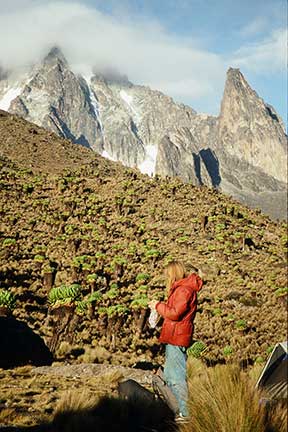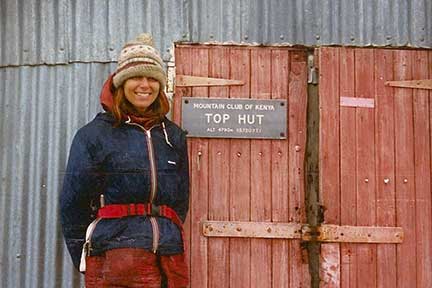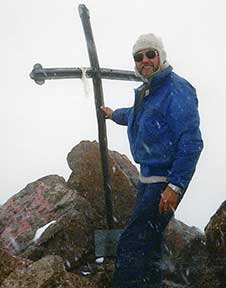 Hiking Mt. Kenya
Hiking Mt. Kenya
February 22 - 24, 1988
Perhaps the idea stemmed from the fact that we missed Alaska's cold fresh air, sparkling water, and snow. Perhaps it had something to do with the fact that we'd spent four months on a truck with little exercise since the High Atlas hike. In any case, by the time we got to Kenya, we were both excited about the idea of climbing Mt. Kenya, the second highest mountain on the African continent.
Of course, we could have climbed Kilimanjaro, but there are so many expenses and requirements that it would have cost a minimum of $200 - $300 each. We'd have been forced to hire at least two guides, and as neither of us enjoy traveling with an entourage, we preferred to backpack on our own for only $30 park entrance and camping fees.
Mt. Kenya, at 17,035 feet, is the tallest mountain either of us had ever attempted. It has three peaks, the highest of which requires technical expertise and equipment. But Point Lenana, at 16,355 feet, can be reached by anyone who is physically fit.
We left the Exodus trucks with our packs at Meru and traveled by high-speed matatu to Naro Moru on Sunday, February 21. Almost immediately, we met some Americans who offered us a lift to the Meteorological Station, where the climb begins. One of the biggest logistical problems in climbing Mt. Kenya is getting transportation to and from this starting point, which is 17 miles from Naro Moru and is not served by public transportation. Trouble was, we had no food. The shops were closed on Sunday and we couldn't attempt the climb unprepared. We had to decline the invitation.
We camped at the Naro Moru River Lodge and watched a violent black thunderstorm blow over the mountain. Hikers returned with stories of how they had turned back because of poor visibility, high winds, and rain. We read the Lodge register, and found not a single really positive comment. "It was the hardest thing I've ever done in my life," wrote one person. "I'm glad I did it, but I'd never do it again," noted another. "You've got to be crazy to climb this mountain!" said several.
There were a number of discouraging remarks about the "vertical bog". The name alone caused a certain amount of trepidation. One traveler left helpful advice. "Take lots of chocolate."
We did—four chocolate bars a day for each of the three days. Monday was a holiday but we found a few shops open and picked up enough food to sustain us for the trip. A Dutch couple, both doctors, gave us a lift in their own vehicle to the park entrance, which was several miles from the Met Station. They didn't want to risk taking their two-wheel drive vehicle up the last stretch of steep and sometimes muddy road. We began hiking up the road but were soon picked up by a local driver and taken (for a fee) to the Met Station, at 10,000 feet. It was still early afternoon and we had plenty of energy, so we asked if it would be possible to continue and camp on the trail.
"Sure," said the ranger, "but there's no water."
"How far is it to the vertical bog?" I asked.
"About three hours' walk from here," he answered. "It should take about three hours more to get through it."
Our goal was to camp at the bottom of the bog and climb it in the morning. We hiked and hiked, thinking we should get to it soon. One place was steep and a little wet, but it was only an hour and a half out of the Met Station and it sure didn't match the descriptions we had read. We kept looking. About four hours later, we decided we must have passed it. The sun was setting and nothing along the trail for a long way ahead looked either vertical or boggy.
We camped in a sandy spot in the middle of the trail. It was the only flat area on the steep rocky ridge (see photo). Tattered clouds blew across the mountain and we sat for a long time on a high rock as ragged fog banks alternately concealed and revealed the sunset sky, the mountain cliffs and valleys below, the lights on the plains to the south, the stars and moon above. It was a breathtaking natural light show.
The next morning was perfectly clear. There was frost on the rocks. We hiked on towards MacKinder's Camp, the base camp for the last push to the top. We had indeed passed the vertical bog without noticing it! The stream below the camp was icy cold and clean, straight from a glacier. It was some of the only water we encountered in Africa that was safe to drink.
We arrived at MacKinder's at about 11:00 a.m., and, feeling energetic, decided to climb on to the peak. Most people sleep at the camp until 3:00 a.m. or so and then climb to the top for sunrise. We had to be in Nairobi the next night without fail to remove our gear from the Exodus truck, and it seemed a bit too much to climb the peak, come all the way down, get the 17 miles to the main road and find transportation to Nairobi all in one day. Besides, Dennis didn't fancy getting up in the middle of the night, so climbing in the afternoon seemed a good idea.
What we didn't know is that the mountain is generally clear in the morning and stormy in the afternoon.
Altitude sickness is not uncommon at elevations over 12,000 feet. We noticed the lack of oxygen. Our heads hurt and our legs and arms felt heavy. Our hearts pounded, and in thickening fog it felt as though we were alone and lost in the world.
 We met a few hikers coming down. Some had attempted to reach the top and turned back. We had no trouble following the trail, but it was farther and steeper than we expected. Dennis began to feel the strain. I was tired, but afraid to stop too long for fear of losing my resolution. Dennis was trying to keep up with me and pushing himself too hard. It was the only time during the trip that he trailed behind me. On most hikes, I struggled to keep up with him!
We met a few hikers coming down. Some had attempted to reach the top and turned back. We had no trouble following the trail, but it was farther and steeper than we expected. Dennis began to feel the strain. I was tired, but afraid to stop too long for fear of losing my resolution. Dennis was trying to keep up with me and pushing himself too hard. It was the only time during the trip that he trailed behind me. On most hikes, I struggled to keep up with him!
After a long time, and a long time more, and another long time, with us concentrating on simply placing one foot in front of the other and bracing against the wind and blowing snow, we sighted the "Austrian Hut." The fog was continually moving. To our right we glimpsed the bottom of a cliff that fell away sheer for thousands of feet. To our left was a glacier as massive as any in Alaska. Three inches of snow had accumulated and it was still falling.
We rested in the Austrian Hut, protected from wind but not cold. Point Lenana was still above us, and although we both wanted to quit and go down, we were sure we wouldn't have another chance at this peak for at least several years and probably forever. We pushed on.
We weren't as close as we'd hoped. On top of a knoll, Dennis stopped and took a picture of the fog.
"What are you doing?" I asked. "This isn't the peak!" The lack of oxygen must be getting to him.
"It looks like the peak to me!" he said. "No one will know the difference. Let's go back down."
"No! We're almost there. We can't quit now. Just rest awhile. It can't be much farther."
He looked at me in despair.
The trail disappeared and we each picked our own way through the ice and boulders, on and on. At long, long last, I saw a pole above me.
"That's got to be it!" I shouted. "Almost there!"
No answer.
"Dennis?"
I moved around, trying to spot him. He was a ways below, leaning against a boulder, his head cradled in his arms.
"Are you all right?" I shouted. The fog absorbed and softened my voice. We were alone on the peak and it seemed to resent our intrusion.
 "Yes," he managed. "Just resting."
"Yes," he managed. "Just resting."
"You're almost there!" Very slowly, he started to climb again, step by step.
Finally, we were both at the top. Dennis took several pictures—looking south toward Kilimanjaro, west toward MacKinder's Camp, and north toward the two higher peaks of Mt. Kenya. Of course, all the photos look the same (like fog). But he wanted proof that we'd been there. It was quite an accomplishment!
We began the descent, and our energy increased as more oxygen became available. The chocolate also helped. We camped at MacKinder's and heard dozens of people setting out between 3:00 and 4:00 a.m. It was nice to turn over and go back to sleep.
It took all morning to hike back to the Met Station. No vehicles were leaving, so we had to keep walking down the road, for miles and miles. I got blisters on my feet. It started to rain. Finally, only 400 yards or so from the Park Entrance, which was concealed by a rise, a truck loaded with hikers offered us a lift. In it was the Dutch couple, who had left to climb at 3:00 a.m. and reached the top in the clear morning weather. We were charged just as much for the 400 yard lift as they were for the whole nine kilometers!
We made it back to Nairobi in time, and while checking out the prices at a fancy Indian restaurant, were invited to come in, stash our packs and eat, despite our ragged appearance. It was understood that we had been "on safari". The waiters wanted to hear all the details!
Go on to The Ugandan Student Scam
Source: www.SusanCAnthony.com, ©Susan C. Anthony
